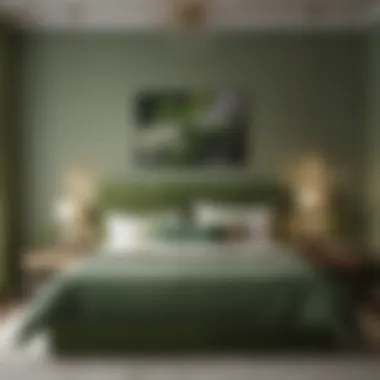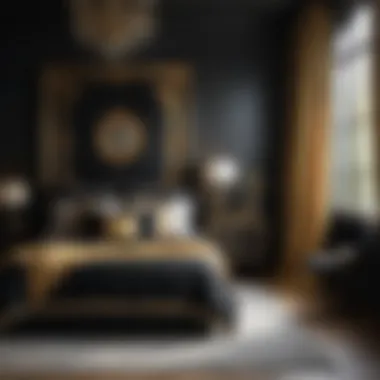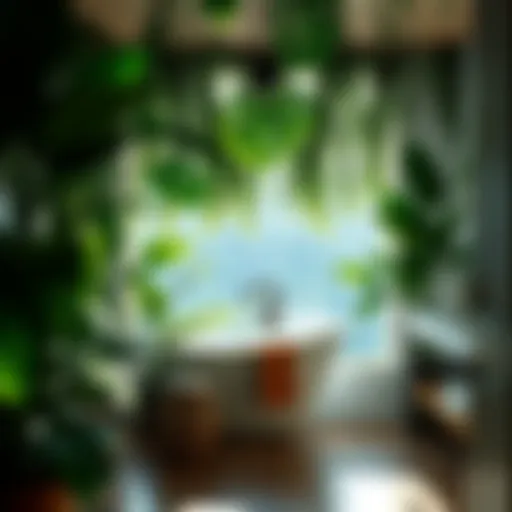Discovering Two-Tone Bedroom Colors for Tranquil Spaces


Intro
In the quest for creating a harmonious bedroom, color plays a fundamental role. The right hues not only beautify the space but also influence mood and comfort. Two-tone bedroom color schemes have emerged as a popular choice among contemporary homeowners. This approach allows for the blend of multiple colors without overwhelming the senses.
Two-tone color schemes provide a versatile solution for different styles and preferences. The contrast between two shades can serve to emphasize certain architectural features or create a specific atmosphere. This guide aims to illuminate various aspects of employing two-tone colors in your bedroom. From current trends to practical applications, we will explore how these choices can transform your space into a serene retreat.
Intro to Two-Tone Bedroom Colors
Two-tone color schemes can transform the aesthetic appeal and atmosphere of a bedroom. They offer a unique way to express personality while balancing functionality and comfort. Choosing a two-tone approach means more than just picking two colors; it involves understanding how those colors interact and influence the space. These combinations can create a sense of harmony, making the bedroom feel inviting and restful.
When homeowners look to enhance their spaces, color often takes center stage. It plays a crucial role in setting the mood and reflecting individual tastes. This introduction highlights the significance of two-tone color schemes, which blend both creativity and practicality. Here, we will delve into essential concepts that explain how these schemes can elevate a bedroom's design through strategic color choices.
Defining Two-Tone Color Schemes
A two-tone color scheme involves the deliberate pairing of two distinct colors in a unified space. This can manifest in various forms, such as walls painted in contrasting hues or the use of different colors in furniture and decor. The goal is to create visual interest without overwhelming the senses.
Two-tone designs can be classified into several categories:
- Contrasting Colors: Using colors that are opposite each other on the color wheel can create a bold statement. For example, navy blue paired with a soft coral can add depth and character.
- Similar Shades: Choosing colors that are adjacent on the color wheel, like teal and blue, provides a softer look while maintaining interest.
- Neutrals and Accents: A neutral base color can be complemented with a more vibrant accent color. This scheme is useful for creating balance, ensuring the room feels both fresh and calming.
Overall, defining the colors to use is the first step in creating a cohesive two-tone bedroom design.
The Psychological Impact of Color
Color has profound effects on our mood and behavior. Each color evokes specific feelings and responses, which are essential considerations when designing spaces where relaxation is key.
- Warm Colors: Shades like red and orange tend to stimulate emotions and can evoke warmth and energy. However, if used excessively, they may create feelings of agitation.
- Cool Colors: Colors such as blue and green are often associated with tranquility and calmness, making them ideal for spaces meant for rest.
- Neutral Tones: While not inherently exciting, neutral colors serve as a backdrop that allows other colors to shine without competing for attention.
For instance, studies show that bedrooms painted in cooler tones can enhance feelings of serenity, promoting better sleep quality.
Understanding these impacts aids in selecting colors that align with the desired ambiance of the bedroom. Therefore, thoughtful consideration must be given not only to personal preference but also to the psychological effects of color combinations.
Choosing the Right Color Combinations
Choosing the right color combinations is crucial when designing a two-tone bedroom. The colors we see in our surroundings greatly influence our mood and perception. A thoughtful color scheme can enhance a bedroom’s welcoming nature, create calmness and elevate the aesthetic appeal of the space. It is not just about what looks good; it’s about how these color choices interact with the room's overall vibe, lighting, and function.
When selecting color combinations, consider the emotions associated with different colors and how they can complement each other. This helps create a balanced atmosphere where tranquility reigns, making your bedroom a personal sanctuary. A poorly chosen color scheme can lead to visual chaos and an discomforting environment, so careful deliberation is needed.
Understanding Color Theory
Primary, Secondary, and Tertiary Colors


Primary colors consist of red, blue, and yellow. These colors form the basis of all other colors. Secondary colors, such as green, orange, and purple, come from mixing primary colors together. Tertiary colors are created by combining primary and secondary colors, adding more depth to your palette. Understanding these distinctions helps in creating a well-rounded bedroom design.
The main characteristic of using primary colors lies in their boldness and vibrancy. They can energize a space. However, too much intensity can be overwhelming. Secondary colors provide a blend that is less striking, which may be better for creating a soothing atmosphere. When mixing these color types, the unique feature of achieving balance plays a significant role. Using them wisely can make a bedroom feel harmonious. Overuse, however, can lead to a cluttered appearance.
The Color Wheel and Its Applications
The color wheel serves as a useful tool in selecting color combinations. It visually illustrates the relationships between colors, making it easier to choose harmonizing tones. Key characteristics of the color wheel include complementary colors (opposites on the wheel) and analogous colors (next to each other). For this article, the color wheel provides a practical approach to designing two-tone spaces.
A unique feature of the color wheel is that it helps in identifying how colors interact. For instance, combining opposites can create striking contrast and draw attention. Yet, when used incorrectly, this contrast can be harsh. In contrast, adjacent colors can provide subtlety, but they might lack the visual impact some designs require. Understanding these dynamics from the color wheel is instrumental for achieving effective bedroom designs.
Complementary Color Schemes
A complementary color scheme involves pairing colors from opposite sides of the color wheel, such as blue and orange or yellow and purple. This approach creates a vibrant and energetic environment. While it adds excitement to the space, it needs careful handling. Too much contrast can lead to a chaotic feel. It’s essential to balance the colors with neutrals.
Analogous Color Schemes
Analogous color schemes involve colors that are next to each other on the color wheel. For example, blue, teal, and green create a serene and cohesive look. This scheme is often more restful to the eye, making it suitable for bedrooms where relaxation is key. It allows for fluidity between colors while maintaining a clear identity.
Monochromatic Approaches
Using variations of a single color forms a monochromatic approach. You might utilize different shades of blue, for instance. This method can lead to an elegant and sophisticated look. It offers simplicity, yet it can be visually very appealing. However, care must be taken to integrate various textures or patterns to avoid a flat appearance.
Incorporating Two-Tone Colors in Bedroom Design
Incorporating two-tone colors in bedroom design serves multiple purposes. It enhances the visual appeal while also allowing for a deeper sense of personal expression. The effective use of two-tone schemes can transform an ordinary space into one that feels more dynamic and inviting. Understanding the balance between color, light, and space is essential when integrating two-tone selections into your bedroom. Consideration should be given to various elements such as the overall layout, existing furnishings, and personal preferences.
Accent Walls and Color Blocks
Accent walls are one of the most popular ways to feature two-tone designs in the bedroom. They act as focal points, drawing attention to certain areas of the room. Choosing the right wall is crucial; often, it is best to select a wall that does not have windows or doors for a clean effect. When applying color blocks, one can explore different patterns, such as stripes, chevrons, or simple geometric shapes. Each option provides a different mood and visual interest. Additionally, think of how chosen colors can interact with natural light throughout the day.
Furniture and Fixtures
Two-tone colors extend beyond walls; they can be applied to furniture and fixtures as well. This approach allows you to create a cohesive look without overwhelming the senses. For instance, a bed frame painted in two complementary shades can act as a stylish feature without clashing with bedroom decor. Consider pillows, lamps, and nightstands that also incorporate two-tone elements, creating a unified aesthetic. Choosing fixtures in one color while keeping the furniture in another can unsettle the balance of the design. Therefore, it’s vital to ensure that furniture pieces complement each other.
Textiles and Accessories
Textiles play a significant role in incorporating two-tone colors. Bed linens, curtains, and rugs can echo the two-tone theme established by walls and furniture. Mixing patterns might be effective but requires caution to maintain harmony. A good rule of thumb is to limit the patterns used while allowing solid colors to dominate for balance. Additionally, accessories like cushions or throws can be added in shades that contrast or complement existing tones. The aim is to create a layered look that feels inviting without appearing chaotic.
"The careful selection of textiles and accessories in two-tone colors can truly elevate a bedroom's ambiance."
In summary, when incorporating two-tone colors in bedroom design, accent walls, furniture, and textiles each play a crucial role. Thoughtful integration of these elements allows for a coherent visual narrative that enhances the overall comfort and appeal of the space.


Practical Tips for Applying Two-Tone Colors
Applying two-tone colors in a bedroom is not merely about selecting two colors that look nice together. It involves creating an environment that balances aesthetic appeal and functionality. Understanding practical tips helps optimize the visual and emotional impact of your chosen colors. Therefore, having these insights at your disposal is essential for achieving a cohesive design that resonates with the intended ambiance.
Creating Balance and Harmony
Achieving balance and harmony in a two-tone bedroom is crucial. This begins with the proportion of each color used. A dominant color often establishes the mood, while the secondary tone adds depth. For example, a light color on the walls can create an airy feeling, while the darker tone can be used on furniture or as an accent wall for grounding.
You can utilize color blocking to emphasize specific areas. This practice involves applying large blocks of color, which draws the eye and creates interest. When considering the layout of the room, think about how each color interacts. For instance, if you opt for a navy blue and soft white combination, the navy may serve better as an accent for bedding, while white could occupy the majority of wall space.
To aid in creating balance, keep in mind the size of your room. Larger spaces can accommodate more dramatic contrasts, while smaller rooms benefit from more subtle pairings to avoid feeling cramped.
Testing Colors Before Commitment
Before solidifying your choice of colors, it is advisable to test them in your specific space. Paint samples on larger swatches of cardboard and place them against the wall. This allows you to see how they look at different times of the day due to the changing natural light.
Do not just rely on the color in-store. Colors can appear very differently depending on the surrounding hues and lighting conditions. It may be beneficial to paint patches on the wall and live with those colors for a few days to see how you feel about them in various circumstances. Consider seeking feedback from friends or family, but always trust your instincts.
Evaluating Lighting Effects
Lighting is a significant factor influencing the perception of color. Consider both natural and artificial light in your space. Natural daylight can bring out the best in colors, while artificial lights may alter how colors are perceived. Warm white bulbs, for instance, can enhance warmer tones, while cool daylight bulbs tend to highlight cooler hues.
Furthermore, assess how shadows and reflections play a role in your design. Some colors may appear washed out in bright light, while others can deepen in the shadows. To ensure your two-tone scheme stands the test of time, evaluate how your chosen colors look under various lighting conditions. Incorporating different light sources in your design, such as lamps and floor lights, can also create different moods and should be part of the overall planning.
"Testing colors and evaluating lighting can save time and ensure your two-tone scheme is successful."
Case Studies: Successful Two-Tone Bedrooms
Examining specific case studies of two-tone bedrooms is essential. These examples provide real-life illustrations of how color schemes can effectively influence ambiance and functionality. By analyzing diverse implementations, readers can gain insight into what works and why. These case studies serve as a practical reference point, allowing homeowners and renters to visualize potential outcomes in their own spaces. They reveal not only color pairings but also how different styles can influence the overall aesthetic.
Modern Minimalist Spaces
Modern minimalist spaces often emphasize simplicity and functionality. Colors in these rooms are chosen not just for beauty, but to create an open and airy feeling. Common combinations include whites paired with soft grays or pale blues.
- Benefits: These subtle hues enhance natural light, giving the illusion of more space. The simplicity of choice avoids overwhelming the senses. Darker accents can be used sparingly for contrast, adding depth without clutter.
- Considerations: Ensure that the color differences are not so stark that they disrupt the serene vibe. The transition between colors should be smooth, often achieved with straight lines or soft curves.
Rustic Retreats
Rustic retreats are characterized by warmth and natural materials. In this setting, colors like warm browns and muted greens work harmoniously together. This combination reflects the outdoors and creates a cozy environment.
- Benefits: Earth tones in two-tone designs foster a sense of comfort. They invite relaxation and connect the interior with nature. Light wood elements can further enhance this scheme, making the space feel more integrated.
- Considerations: The balance between rustic charm and modern features should be maintained. Overly vibrant colors might counteract the desired warmth. A thoughtful color approach can lead to a tranquil space that feels welcoming.


Contemporary Eclectic Designs
Contemporary eclectic designs celebrate diversity in styles and colors. For these bedrooms, vibrant pairs like teal and orange or purple and yellow can be effective. Such combinations create dynamic visual interest.
- Benefits: The use of bold colors allows for personal expression. It reflects the owner's personality, turning the bedroom into a vibrant sanctuary. These spaces often include furniture and decor that complement the chosen color scheme, making them cohesive yet varied.
- Considerations: While eclectic designs encourage mixing, it is important to find balance. Too many competing colors can lead to chaos rather than harmony. Textures can play a supporting role here as well, unifying disparate elements.
"The right two-tone approach can transform a space from mundane to extraordinary and reflect the individuality of its inhabitants."
In these varied case studies, the application of two-tone colors demonstrates that choices are influenced by the desired atmosphere. From minimalism to eclecticism, each style shows that with careful consideration, beautiful outcomes are achievable.
Common Mistakes in Two-Tone Color Application
When embarking on the journey of selecting two-tone colors for a bedroom, it is essential to understand potential pitfalls. Common mistakes can hinder the effectiveness of this design choice. Making informed decisions will lead to a harmonious and appealing environment.
Overly Complicated Schemes
One prevalent mistake is creating overly complicated color schemes. While the idea of mixing multiple colors may seem appealing, it often results in a chaotic visual experience. It is advisable to limit the palette. Typically, two shades can effectively complement each other and create a sophisticated look. For instance, pairing a soft beige with a deep navy can provide contrast without overwhelming the space.
Additionally, an excessive number of tones can detract from the overall design. This complexity confuses the eye and disrupts the intended aesthetic. Focus should be on simplicity and elegance.
"Simplicity is the ultimate sophistication."
— Leonardo da Vinci
Ignoring Scale and Proportion
Another common error is ignoring scale and proportion when applying two-tone colors. It is crucial to consider the size of the bedroom and the effect of the chosen colors on that space. Dark colors can make a small room feel even smaller, while light tones have the opposite effect.
For example, if a large area is painted in a dark shade, it may dominate the space, creating an imbalance. Conversely, applying a light color to a larger wall can open the room up. Understanding how these colors interact will lead to more effective choices.
When applying color in this context, one should also pay attention to the proportions of each color. A good rule is to use the 60-30-10 rule. This involves using one color for 60% of the room, a second color for 30%, and a third for 10% in accents. This ensures a balanced appearance, guiding the eye through the space naturally.
Ending: The Power of Two-Tone Colors
In the realm of bedroom design, the choice of color is paramount. Two-tone color schemes offer not just aesthetic appeal but also a functional approach to creating a personal sanctuary. Utilizing a palette of contrasting or complementary hues can dramatically influence the mood of a space. It enhances the overall atmosphere, making it both welcoming and serene.
The benefits of employing two-tone colors are numerous. First, they allow for greater creativity in design. Homeowners can express their personality through unique combinations that might not be possible with a single color. Furthermore, two-tone schemes can visually define spaces, particularly in smaller bedrooms. By dividing areas using color, one can create a greater sense of depth and dimension.
When considering the practical aspects of two-tone colors, it is essential to take lighting into account. Colors can change appearance depending on natural and artificial light. Therefore, it is advisable to test color samples in the actual space before making a final decision.
Additionally, the psychological impacts of color cannot be ignored. For instance, softer shades can evoke tranquility, while bolder hues may energize the room. Understanding how colors interact psychologically helps in selecting the right combination for your bedroom.
Final Thoughts on Creating Personal Sanctuary
Creating a personal sanctuary is about more than aesthetics. It is about cultivating a space that resonates with the individual. Two-tone colors play a crucial role in this process. The right combination can significantly influence feelings and perceptions within the room.
- Experiment with Different Combinations: Do not hesitate to try various palettes until you find one that feels right.
- Understand the Light in Your Space: Natural light changes color perception, so view colors at different times of day.
- Invest in Quality Paint: The finish and durability of the paint matter in achieving the desired look.
Color choices are deeply personal and should align with one’s lifestyle and preferences. Ultimately, a well-designed bedroom with two-tone colors can be a profound source of calm and a reflection of one’s unique taste.



